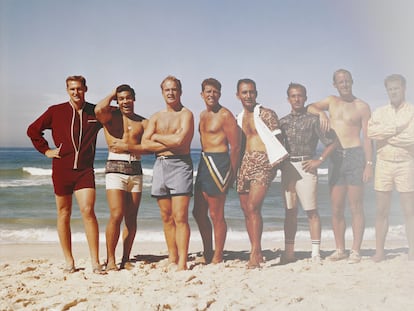Bulges, controversies and 45-year-old abs: Are we experiencing a new golden age of underwear ads?
After the rise of athletes, singers and DJs, who are analyzed inch by inch, Usher, a middle-aged man, has joined the ranks of celebrities who pose in front of a camera wearing only their boxers


In 2019, the New York Times announced: “Underwear Ads Lose the Macho: How Marketing Has Embraced Real Men.” If that was the case, it was short-lived. Just as people argue that runway models are thin because dresses must have a drape, flounce and flow that only comes from hanging off a body without curves or relief, it seems that briefs can only be appreciated in their full glory if they’re pulled taut under a flat, squared-off belly and over strong legs. Besides, this type of advertising has been on a roll for four decades — why change it? Singer and actor Usher just added a new chapter by becoming the face of the Kim Kardashian-owned Skims men’s underwear line at age 45. He doesn’t look 45, and he doesn’t pretend to look 45, judging by his abs, but the number is there: a man who is closer to 50 than 30 is the latest to appear half-naked in his skivvies.
Underwear ads are both a source of controversy and a perpetuation of normative physiques; they are a barometer of celebrity and an indication of the current state of male beauty — it’s the photo a man shows to his trainer and says, “I want to look like this.” Underwear ads have embraced many realities: they have included white, Black and Asian men, men with classically beautiful faces and Martian beauties. The bodies? Sometimes they are more muscular, other times they are lankier, but they never resemble ordinary people. Sometimes, however, on special occasions, the ad campaigns do break norms. For instance, Rihanna’s Fenty line has been applauded for showing models with real bodies for its line of briefs (which also includes boxers with lace and transparencies). Last year, Calvin Klein featured a transgender man who had not undergone a mastectomy to advertise the brand’s bras (much to the horror of the conservative press). But these images were a mirage in the usual oasis of the month leading up to Pride, when all brands experiment with inclusivity. During the rest of the year, by and large, masculinity continues to look the same.

Just a month ago, actor Jeremy Allen White (who combines a Martian-like beauty with a CrossFit body) proved that there are classics that always repeat themselves, like a celebrity running around in his underwear still being able to start a conversation, cause traffic jams in front of bus stops and make the news. In his case, it was a rebound controversy: when a Calvin Klein ad starring FKA Twigs was censored in the U.K., there were accusations of double standards; we can see a man running around naked in his underwear, but a woman, not so much. Or a twist on that point: the objectification of the male body is celebrated, while we’ve finally begun to question the objectification after too many decades. In any case, all this begs the question: is men’s underwear advertising experiencing a new golden age?
The waistband’s aspirational aspect
Men’s underwear advertising often draws on sheer beauty and the now-familiar notion of the aspirational: a rubber waistband with a recognizable brand above the pants is, for some, something that makes you sexy; it’s a way to be a little less imperfect. “Undress with confidence whatever the occasion,” they say on Calvin Klein’s website, if one wants to buy their briefs. It’s advertising’s simplest syllogism: if I wear the same underwear as that muscular guy on the marquee, I will look a little more like him and a little less like myself.
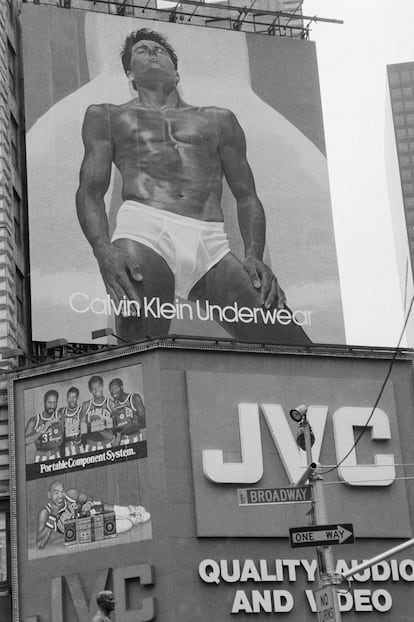
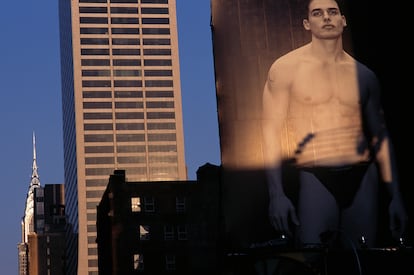
In the 1980s, Calvin Klein had already hired recognizable models and athletes, such as the Olympic pole vaulter Tom Hintnaus, and put them in front of legendary photographers (Bruce Weber and Richard Avedon), but Mark Wahlberg, then known as Marky Mark, changed everything. In October 1992, the rapper had appeared on the cover of Rolling Stone magazine wearing Calvin Klein boxer shorts and gave the brand the idea (according to legend, it was millionaire and investor David Geffen’s idea) to hire him as a model. A Herb Ritts photograph of Marky Mark grabbing his genitals did the rest.

We’d seen daring underwear ads before: a 1985 Calvin Klein campaign photographed by Bruce Weber showed two men and a woman, all in their underwear, sleeping together on a couch. The elements of Wahlberg’s famous photo weren’t even new: we’d seen models in briefs, and we’d seen celebrities grabbing their genitals (it was a regular part of Michael Jackson’s choreography, though it was hard to find anything sexual about it), but never all together with such aesthetics and yet so much carnality. In old underwear ads, the men were muscular mannequins, but Marky Mark was an impertinent young man touching his private parts on giant marquees while staring defiantly at the camera. And he was a famous young man, to boot: he had just had a number one hit with Good Vibrations, with his band Marky Mark and the Funky Bunch; he also sang shirtless. In fact, Wahlberg was almost always in his underwear on stage. It would have been unusual to photograph him clothed.
The formula has continued to work over the years, with variations at different times and attempts to make the underwear increasingly less visible and flesh ever more visible. In 1997, model Renaud Tison showed his butt in a Gucci Underwear ad photographed by Mario Testino. In 2001 Calvin Klein went one step further and showed what everyone wanted to see: a huge bulge. Model and actor Travis Fimmel posed for the U.S. brand in teeny-tiny boxer shorts that he filled out enviably. The image caused traffic problems in cities like London, where the giant billboard dominated the city. In 2002, the Advertising Standards Authority (ASA, the same people who have been shouting to the heavens about the FKA Twigs ad) withdrew their accusations against the brand for having made a poster that was “indecent, sexually suggestive and degrading to men.”
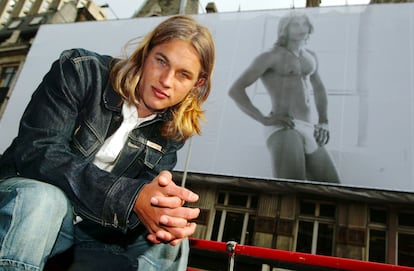
In 2004, Swedish footballer Freddie Ljungberg made it fashionable to pull sports stars off the field to sell underpants. Fimmel filled out the underwear marvelously. The fun was no longer just seeing a celebrity in boxer shorts, but seeing a celebrity in boxer shorts with an endowment worthy of commentary. Whether that endowment was real or not was not yet a matter of debate (that conversation came later and is discussed below). In 2006, Dolce & Gabbana upped the ante by showing the Italian national team in the locker room wearing just their underwear. In 2008, Armani called David Beckham; his bulge was also commented on, especially as strange bulges had now started to appear, ones that were bulky but without a recognizable silhouette.
Inch by inch
In 2015, Calvin Klein invested in the most talked-about person in the world. Justin Bieber, then 21 years old, made those ads that were once admired on huge billboards and simply caused some traffic jams to happen; but with social media weighing in on the debate, the ad was scrutinized inch by inch, no pun intended. “How much was Justin Bieber’s package Photoshopped?” everyone wondered. But the worst part is that someone answered the question: the website BreatheHeavy got the unretouched images (said to have been sent by someone who had participated in the session and editing and who obviously skipped all confidentiality clauses) and published them (he had to delete them later, after a lawsuit). The difference between the before and after (in the volume of the pecs, arms, butt and, yes, genitals) evidenced what the world already suspected. However, the before and after of those particular photos were not as important as the before and after of how ad campaigns featuring celebrities in their underwear are received. Shawn Mendes also posed for the brand in 2019; he, too, was comprehensively analyzed: social media ruled that his bulge was too small.
That didn’t happen to DJ and producer Calvin Harris, when he showed off the many hours he spent in the gym in a campaign for Armani in 2015. Social media users judged that his bulge looked great, and nobody questioned it. The shunning and mockery, it seems, only served for post-adolescent singers around whom rumors about their sexuality were swirling. Harris, a grown man with a long list of lovers, was not questioned.

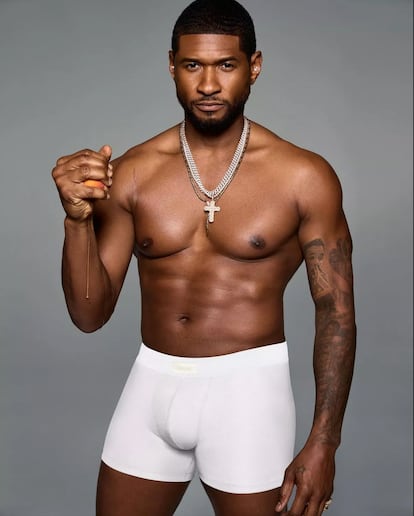
Usher’s ad campaign, at 45, marks a new direction with a model over 40 (Beckham last posed in boxer shorts for H&M at 37), whether he looks that age or not. In addition, the ad’s line, “what I like most about acting is that element of intimacy between me and my audience,” inevitably recalls Brooke Shields’s controversial phrase (“You want to know what’s between me and my Calvins? Nothing”) from the Calvin Klein jeans ad that she shot when she was only 14 years old. The campaign altered the course of fashion advertising forever: a well-known and attractive face, sensual candor, an uncomfortable element and millions of people at home. Now, of course, they have Usher’s bulge. “Usher distracts fans with huge bulge as he strips off for skintight Skims photoshoot,” the Daily Star’s headline declared. The bulge in question is still inhuman, unreal, impossible. What’s between those briefs and reality? Nothing, it’s just advertising.
Sign up for our weekly newsletter to get more English-language news coverage from EL PAÍS USA Edition
Tu suscripción se está usando en otro dispositivo
¿Quieres añadir otro usuario a tu suscripción?
Si continúas leyendo en este dispositivo, no se podrá leer en el otro.
FlechaTu suscripción se está usando en otro dispositivo y solo puedes acceder a EL PAÍS desde un dispositivo a la vez.
Si quieres compartir tu cuenta, cambia tu suscripción a la modalidad Premium, así podrás añadir otro usuario. Cada uno accederá con su propia cuenta de email, lo que os permitirá personalizar vuestra experiencia en EL PAÍS.
¿Tienes una suscripción de empresa? Accede aquí para contratar más cuentas.
En el caso de no saber quién está usando tu cuenta, te recomendamos cambiar tu contraseña aquí.
Si decides continuar compartiendo tu cuenta, este mensaje se mostrará en tu dispositivo y en el de la otra persona que está usando tu cuenta de forma indefinida, afectando a tu experiencia de lectura. Puedes consultar aquí los términos y condiciones de la suscripción digital.
More information
Archived In
Últimas noticias
Most viewed
- Sinaloa Cartel war is taking its toll on Los Chapitos
- Oona Chaplin: ‘I told James Cameron that I was living in a treehouse and starting a permaculture project with a friend’
- Reinhard Genzel, Nobel laureate in physics: ‘One-minute videos will never give you the truth’
- Why the price of coffee has skyrocketed: from Brazilian plantations to specialty coffee houses
- Silver prices are going crazy: This is what’s fueling the rally

